Plagiarism and Cheating
Student Dialog - What is Cheating?
Lori : Hey guys, haven't seen you since the semester started.
Brian, Sage, Deena, Jose : Hi Lori!
Brian : How's your second semester going?
Lori : It's going OK. Just trying to keep up with all my assignments. How about yours?
Brian : It's OK. I'm having some trouble keeping up in math class, but I've got a friend who is going to help me out, so I think I'll pass.
Jose : How is this friend going to help you?
Brian : Well, he already had the class, so I'm just going to use his homework and change the answers some. It's not like I'm not going to study, because I'm studying his notes!
Sage : Whoa there, Brian. Isn't that a violation of the academic integrity policy?
Deena : Yeah Brian. I'd be careful if I were you. I think that's called cheating.
Brian : You serious? I'm studying, so why is it cheating?
Jose : Way serious man. It's cheating because you plan to turn in homework someone else did and pretend you did it.
Brian : But I studied and I made some changes.
Lori : Get real, Brian. You know that's cheating. Why don't you let us help you study instead of using your friend's homework?
Jose : Yeah, I've already had that math class. I can help you understand the problems better.
Deena : You could also go to Penn State Learning Center for help. They have math tutors there who can help you. That's where I went for help with my math course.
Brian : I guess I could do that. I never really thought about what I was doing as cheating. I certainly don't want to be considered a cheat, nor do I want to get caught cheating! Thanks for setting me straight guys!
Jose : Even if you get a lower grade, it's better than knowing that you only got a good grade because you cheated.
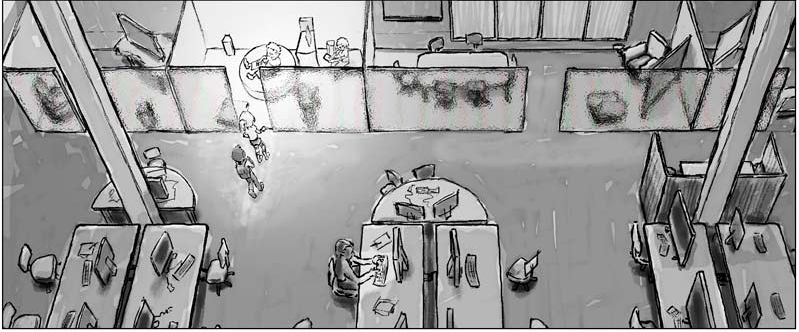
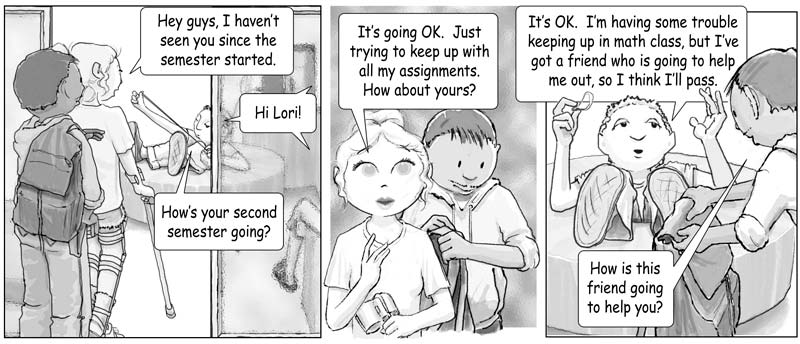
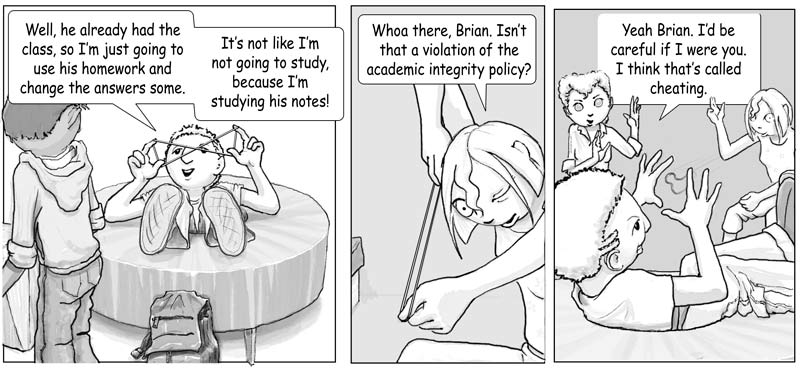
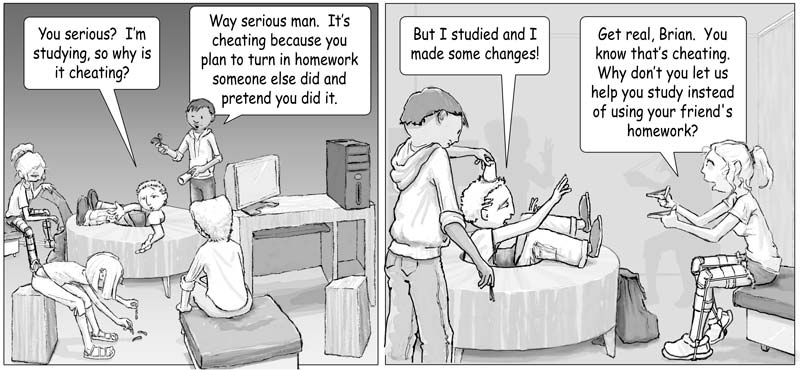
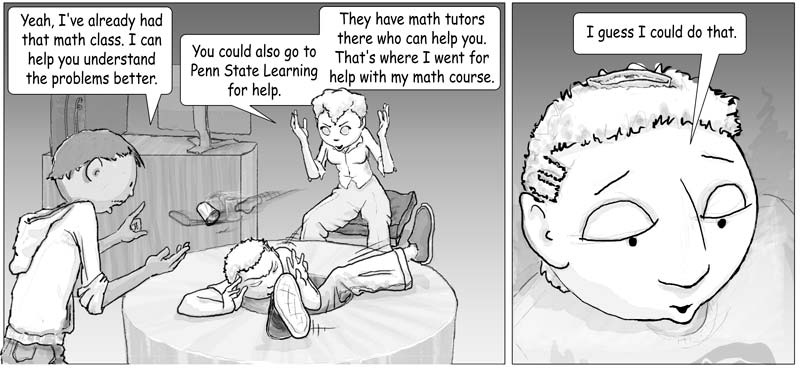
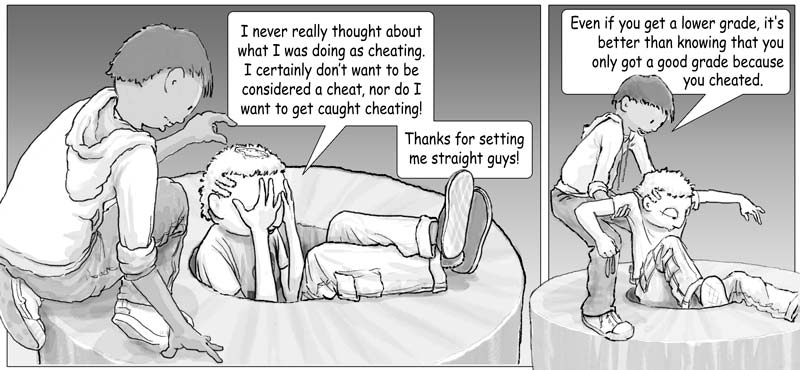
Academic cheating is anything you do to make it appear that someone else's work is your own or allowing someone else to copy your work and submit it as their own. It can include sharing another's work, copying answers on an exam or homework assignment, buying a research or creative paper, paying someone else to do your work for you, obtaining copies of exams, homework assignments, and notes and using them in place of doing your own work, etc. When grades, rather than education, become the focus, students become more willing to do whatever it takes to get an "A." Although some acts of cheating are unintentional - the student doesn't realize what he/she is doing is considered cheating - most of the time students know when they are doing something wrong.
Student Dialog - What is Plagiarism?
Jose : Did you hear what happened to that guy in our composition class?
Brian : No, what guy?
Jose : Phil. The guy that always leaves class early.
Brian : Oh yeah, him. What happened to him?
Jose : He got caught plagiarizing and is in big trouble!
Sage : Hi guys, what's up?
Jose : Hey Sage. I was just telling Brian about Phil getting caught plagiarizing.
Sage : Yeah. That was tough man. But he should have known better. Google and Turnitin.com make it easy for faculty to catch students who steal the work of others -- especially if they just copy and paste it from the Web.
Brian : Yeah, I know. But this worries me some. What if Phil didn't mean to plagiarize?
Sage : Well, if he didn't mean to, then he can discuss that with his professor.
Deena : Hi, guys. I heard you talking about plagiarism. I've always been confused about the difference between plagiarism and cheating.
Jose : Well, first, plagiarism is a form of cheating.
Sage : That's right. The way I understand it, plagiarism is when someone copies or uses somebody else's work and acts like it is theirs.
Brian : OK. That's pretty clear. So if you copy something, you should give the author credit for it. But I still don't see how professors would know when someone has plagiarized the work of others.
Sage : Well, most professors can tell when you've used the work of some author in their particular field. Plus, they can use resources on the Web like Google and Turnitin.com to see if the text in your paper came from a Web site.
Brian : Turnitin.com? What's that?
Sage : Well, it's a computer database that professors can use to check student papers for plagiarism. What they do is, they submit the paper and the database checks it against millions of documents and sends the professor back a report listing any text that is not original. Then the professor can go through each of the instances that Turnitin has found and verify whether or not they are properly cited.
Brian : Wow, that's pretty high-tech! Guess we all better be careful not to copy and paste when we write our papers!
Jose : Instructors also keep papers from previous semesters and previous assignments. Even if you copy something that can't be checked by Google or Turnitin because it isn't on the Web, instructors tend to remember what other students have written and can check through their inventory of student papers to see if the paper you are handing in has been copied.
Deena : It's also important to make sure you cite the work correctly if you do copy and paste. In addition to giving the author credit, you also need to format the text correctly by indenting it and putting it in quotes.
Brian : My instructor told us to use the Chicago Manual of Style when citing sources in our papers. The style guide covers how to format and cite the text when you are copying and pasting exact text.
Deena : At any rate, learning how to write a paper and correctly cite sources are important skills to have. Isn't that why we're here in the first place? To learn?
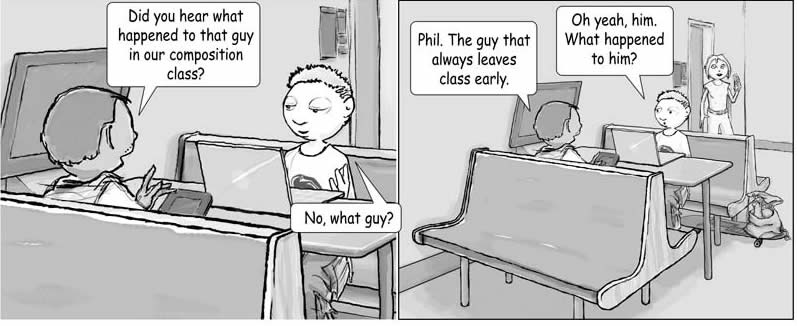
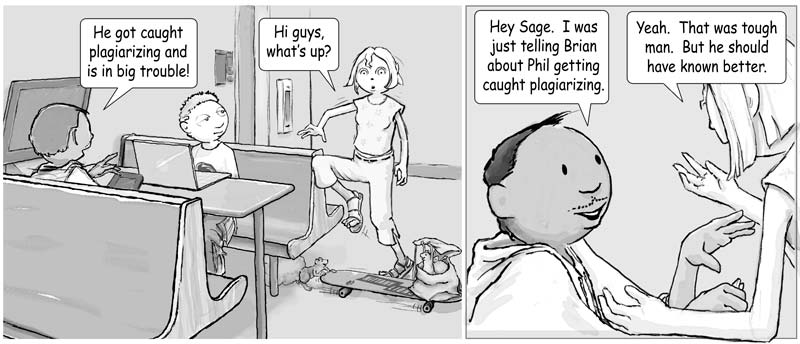
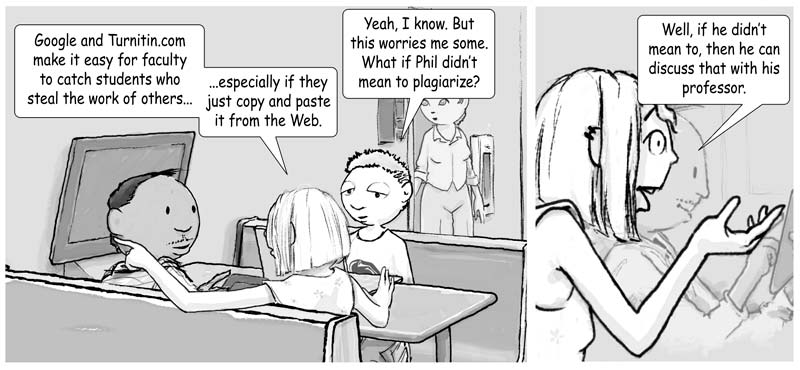
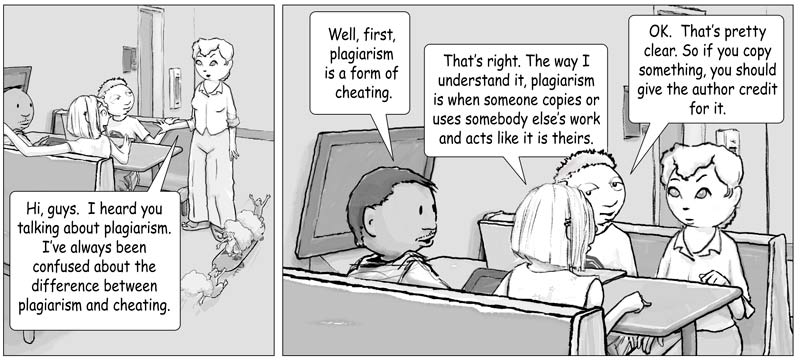
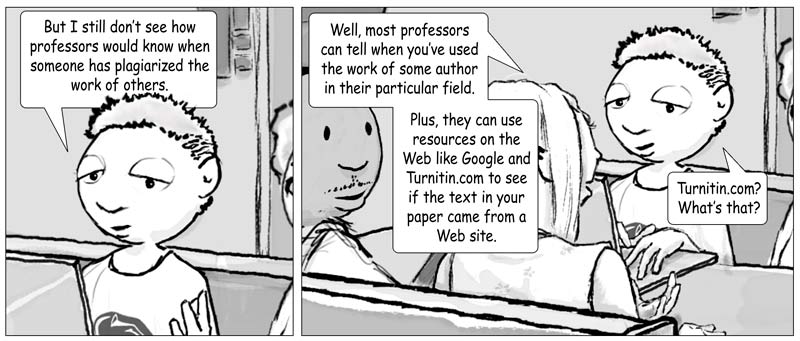
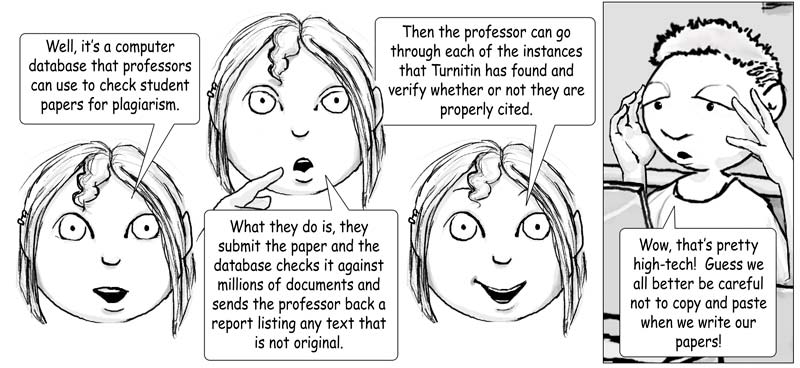
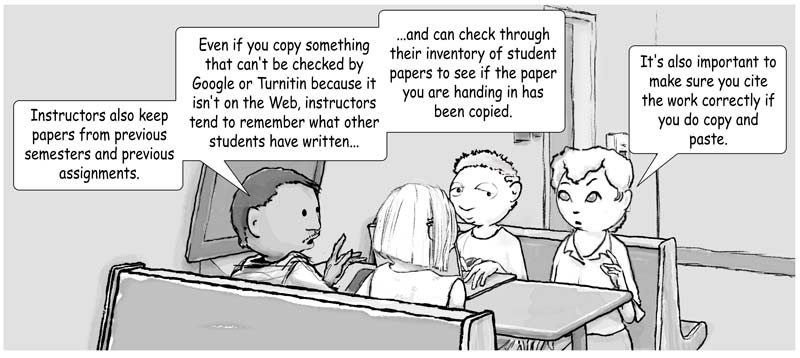
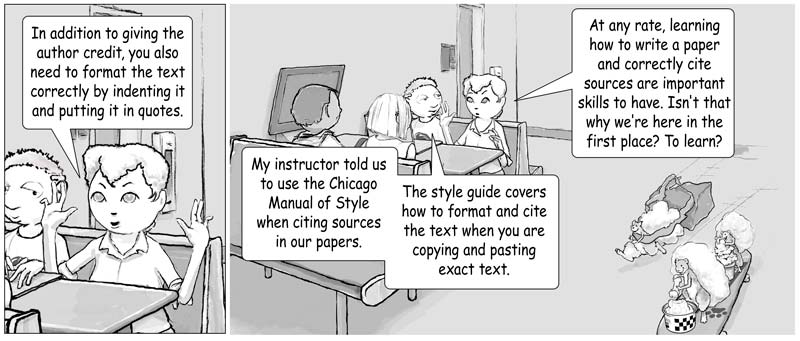
* Turnitin.com is a plagiarism detection tool to which Penn State has a license. All instructors within the Penn State community who are currently teaching a bona fide Penn State course may have an account at Turnitin.com and may submit student work for verification. As a student at Penn State, it is your responsibility to know what constitutes plagiarism and what the penalties are for getting caught. More information about Turnitin.com is available at the Penn State Turnitin Web site as well as at the Turnitin.com Web site.
Like cheating, plagiarism is also implying that another person's work is your own. Plagiarism is a form of cheating. You commit plagiarism if you:
- Submit a paper you have not written to be graded or reviewed as your original work.
- Copy answers or text from another classmate and submit them as your own.
- Quote or paraphrase from another paper, book, journal article, or Web page without using quotation marks, indenting the block of text, and crediting the original author.
- Use long pieces of text or unique phrasings without using quotation marks, indenting the block of text, and acknowledging the original source.
- Cite data without crediting the original source.
- Propose another author's idea as if it were your own.
- Present another author's structure or sequence of ideas as your own without giving the original author credit.
- Fabricate references or use incorrect references.
- Submit someone else's computer program or spreadsheet with minor alterations as your own work.
- Use the same paper, project, or something you created in high school for a current undergraduate course without permission from the faculty member.
This is not a definitive list - any action which implies that someone else's work is your own can be considered plagiarism. However, things like studying in groups and copying a classmate's notes from classes you may have missed are not necessarily acts of plagiarism or cheating. These are things your instructor should address when giving an assignment. If you have any questions about whether working together and sharing notes is OK or not, ask your instructor. It is better to ask for clarification before you start than to have to defend your actions later.
The following Web sites provide examples of the different types of plagiarism. Pay attention to the fact that avoiding plagiarism is not as simple as not "cutting and pasting" from other documents:
- Avoiding Plagiarism (PDF) (UC-Davis)
- Unacceptable Paraphrases (Indiana University Writing Tutorial Services)
- Avoiding Plagiarism (Northwest Missouri State University Owens Library)
- Academic Integrity (Penn State Library Learning Services)
Sometimes the boundaries between research and plagiarism can be ambiguous. The OWL Avoiding Plagiarism Web site has a good discussion on the boundary between using other people's research and plagiarism (see reference 1).
Why Plagiarism and Cheating are Wrong
Penn State is an institution of both learning and research. When you cheat and commit plagiarism, you hurt yourself and the community in the following ways (see reference 1) :
- You deny yourself the opportunity to learn and practice skills that may be needed in your future careers. You also deny yourself the opportunity to receive honest feedback on how to improve your skills and performance.
- You invite future employers and faculty to question your integrity and performance in general.
- You damage Penn State's reputation and invite others to question the integrity of Penn State and the value and validity of degrees issued by Penn State.
- You commit fraud on faculty who are evaluating your work.
- You deprive another author due credit for his or her work.
- You show disrespect for your peers who have done their own work.
Unintentional Plagiarism - How to Properly Cite a Reference
Like cheating, some acts of plagiarism are unintentional - the student simply doesn't realize that what he/she is doing is wrong. One of the most common errors is not citing sources used for an assignment.
When do you need to cite your sources? The short answer is that you should cite a source any time you incorporate into a project, report, or paper an idea, quote (written or spoken), data, image, or other content that is not yours no matter where it came from, unless it is common knowledge.
The term common knowledge refers to any knowledge that you can reasonably expect other people to know. For instance, the fact that there are bilingual speakers in the United State is common knowledge. You would not have to cite any sources.
The specific percentages or numbers of bilingual speakers would not be common knowledge. If you were using any graphs or numbers about how many bilingual speakers are in the United States, you would need to cite where you obtained the information. If someone, like a professor, told you the information in person or via e-mail, you can cite it as a "personal communication."
There are several citation standards such as MLA, APA, Chicago Manual of Style, and more. Links to several common style guides are available from the Penn State library "Citation and Writing Guides" http://www.libraries.psu.edu/psul/researchguides/citationstyles.html.
However, you should always follow whichever citation or bibliography format your instructor gives you.
Citation Guidelines
(see reference 2)


